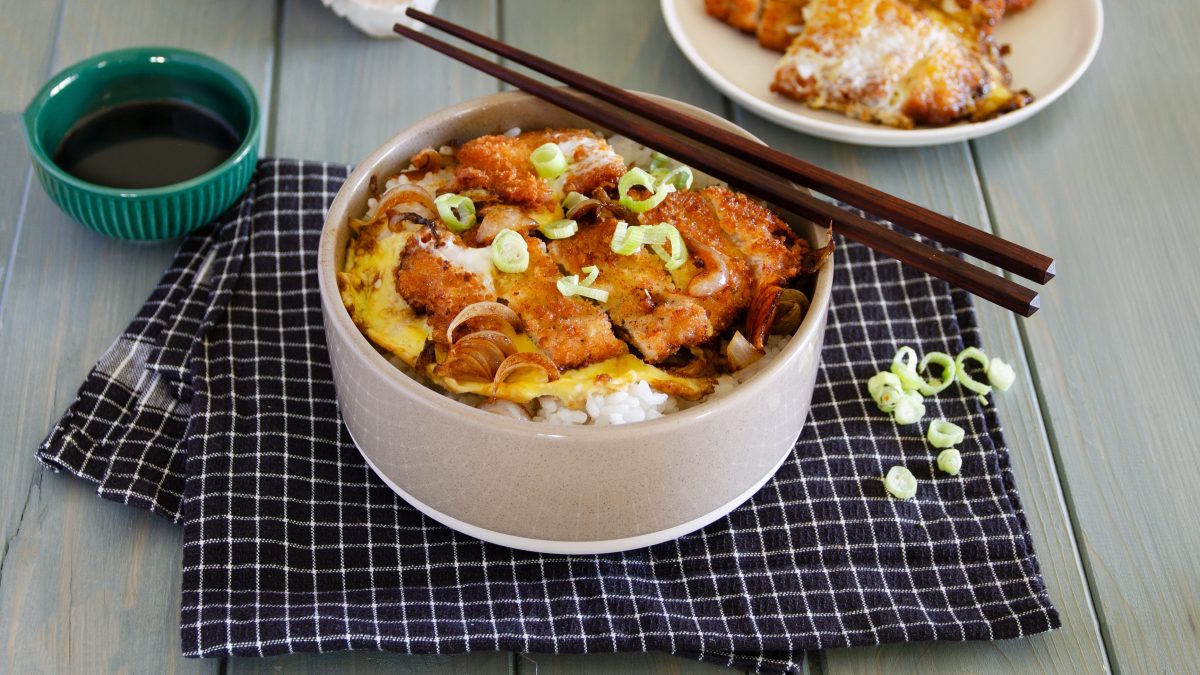
Katsudon is a tasty and substantial dish, typical of Japanese cuisine. It is one of the most popular variations of donburi (literally, "bowl"), a dish made with fish, meat and vegetables, served on a bed of gohan rice. Usually eaten as a main dish, perhaps completed with a portion of vegetables, it is ideal to serve to adults and children for a quick, but very satisfying meal.
In our version, the boiled rice is topped with a crispy pork cutlet (called tonkatsu): we chose slices of pork loin, dipped in egg, flour and panko, then fried in plenty of hot seed oil. When they are golden brown, they are transferred to a pan with a base of caramelized onions with sugar and soy sauce, then covered with a beaten egg.
All that remains is to garnish with a fresh spring onion, cut into rounds, and that's it. With a few simple ingredients, you will make a delicious and quick recipe, considered by the Japanese also as a sort of "lucky charm", to be consumed before an important event , an exam or a competition: katsu , in fact, means "victory".
What is Pork Katsudon?
Katsudon, a beloved Japanese dish consisting of a breaded and fried pork cutlet (tonkatsu) served over rice and topped with a savory egg and onion sauce, has its roots in the early 20th century in Japan. The dish combines the rich, crispy texture of tonkatsu with the comforting warmth of a rice bowl, making it a popular choice for a hearty meal. The name "katsudon" is derived from "katsu," the Japanese word for cutlet, and "donburi," meaning rice bowl. Katsudon became widely popular in Japan in the post-war era, symbolizing success and good fortune due to the wordplay linking "katsu" to "katsu," the verb meaning "to win" or "to be victorious."
As Japanese cuisine began to gain traction internationally, katsudon made its way to the United States in the mid-20th century, particularly as Japanese immigration and the popularity of sushi expanded in the 1960s and 1970s. In the U.S., katsudon was embraced for its rich flavors and comforting nature, becoming a staple at Japanese restaurants and an accessible entry point for those unfamiliar with more traditional Japanese fare. Today, it's enjoyed both in Japanese eateries and home kitchens across the U.S., often found as a beloved comfort food on menus and in food courts.
Pro Tips for The Best Pork Katsudon
- Opt for fresh, high-quality pork loin or pork tenderloin for the cutlet. The meat should be tender, juicy, and not overly fatty. If you're using frozen pork, make sure it’s fully thawed before breading and frying.
- For the crispiest tonkatsu, use panko breadcrumbs. They create a lighter, crunchier texture compared to regular breadcrumbs. Press the pork into the panko firmly for even coating, but don’t overdo it—too much breading can result in an overly thick crust.
- Fry the pork cutlet in hot oil at around 170°C (340°F). If the oil is too cool, the breading will absorb more oil and become greasy; if it’s too hot, the breading may burn before the pork is fully cooked. Test the temperature by dropping in a small piece of panko—it should sizzle immediately.
- When preparing the sauce, be sure not to cook it for too long or let it reduce too much, as it should remain light and flavorful, not too thick or overpowering. The perfect katsudon sauce is savory, with just a touch of sweetness, so adjust the sugar and soy sauce to suit your taste.
- When adding the egg to the sauce, don’t overcook it. The egg should cook just enough to create a silky texture, not scramble. Pour the egg over the pork and allow it to gently set, leaving the yolk slightly runny for an authentic, tender bite.
How Many Types of Katsudon Are There?
There are several types of katsudon, with variations in preparation and ingredients, but they generally fall into a few main categories. Here are the most common types:
- Traditional Katsudon (Katsuto Donburi): This is the classic version, featuring a breaded and deep-fried pork cutlet (tonkatsu) served over a bowl of rice, topped with a lightly cooked egg and a savory-sweet sauce made from dashi, soy sauce, and mirin. This is the most common and iconic form of katsudon.
- Katsu Don with Chicken (Chicken Katsudon): In this variation, instead of pork, a breaded and fried chicken cutlet (usually chicken breast or thigh) is used. It's served in the same way as traditional katsudon, with the same egg and sauce mixture, offering a different flavor while maintaining the comforting qualities of the original dish.
- Cheese Katsudon: This is a modern twist on the classic dish, where a slice of melted cheese is added to the top of the pork cutlet before serving, adding a creamy richness to the crispy cutlet. Some versions may also involve mixing cheese into the egg sauce for a richer texture.
- Katsudon with Curry (Katsu Curry): A variation of katsudon that combines the concept of katsudon with Japanese curry. In this dish, the crispy pork cutlet is served over rice, but instead of the typical egg and sauce topping, it's served with a generous portion of rich, savory curry sauce.
- Tonkotsu Katsudon: This is a slightly more indulgent variation where the pork cutlet is served with a rich tonkotsu broth or a creamy sauce, giving the dish an extra layer of depth and flavor compared to the classic katsudon sauce.
- Katsudon with Pork and Vegetables: Some variations of katsudon may include additional ingredients such as vegetables, like onions, mushrooms, or even leafy greens, cooked in the sauce along with the pork. These additions can add more flavor and texture to the dish.
Katsudon Vs. Tonkatsu
Tonkatsu is a breaded and deep-fried pork cutlet typically served with shredded cabbage and rice, often with a savory tonkatsu sauce on the side. Katsudon, on the other hand, is a variation of tonkatsu where the fried pork cutlet is placed over a bowl of rice and topped with a cooked egg and a savory sauce, making it a more complete, one-bowl meal.
How Many Calories Are in Katsudon?
The calorie content of katsudon can vary depending on the portion size, ingredients, and preparation method. On average, a standard serving of katsudon contains approximately 700 to 900 calories.
What Sauce is Used for Katsudon?
The sauce used for katsudon is a savory-sweet mixture made from dashi (a Japanese broth), soy sauce, mirin (a sweet rice wine), and a bit of sugar. Sometimes, sake is added for extra depth. The sauce is typically simmered with onions and then poured over the crispy tonkatsu (fried pork cutlet) and served with rice. The sauce also helps cook the egg that’s added to the dish, contributing to katsudon’s signature rich, comforting flavor.
How Can I Serve Katsudon?
Katsudon is typically served as a one-bowl meal, where a crispy tonkatsu (fried pork cutlet) is placed over a bed of steamed rice and topped with a savory egg and sauce mixture. To enhance the dish, you can garnish it with scallions or pickled vegetables like tsukemono for a fresh contrast. It’s often paired with a light side, such as miso soup or a simple salad with sesame dressing, to balance the richness. For extra flavor, you can add toppings like shredded nori (seaweed) or a drizzle of tonkatsu sauce. It’s best served immediately to maintain the crispy texture of the pork and the tender egg.
Can I Use Other Proteins?
Yes, you can definitely use other proteins in katsudon! While the traditional version uses pork, you can substitute it with chicken for a chicken katsudon, using a breaded and fried chicken cutlet instead. For a lighter option, you can also use tofu by pressing, breading, and frying it until crispy. Each protein works well with the same savory sauce and egg topping, giving you a delicious variation of the classic dish.
Can I Make Katsudon Ahead of Time?
Well, not really! Katsudon is best served immediately after preparation. The crispy pork cutlet should remain crunchy, and the egg should be tender and soft. If left for too long, the breading will soften, and the overall dish will lose its texture. You can, however, prepare the rice and the sauce ahead of time!
Does Pork Katsudon Freeze Well?
Pork katsudon doesn't freeze well in its entirety because the crispy texture of the fried pork cutlet can become soggy once thawed and reheated. However, you can freeze certain components separately.
The fried pork cutlets can be frozen before they're added to the dish. When ready to serve, reheat the pork cutlet in the oven to restore some crispiness, then assemble the katsudon with the sauce and rice. This method helps maintain the best texture, but the overall dish won't be quite the same as when freshly made.
How to Store Pork Katsudon
Place the fried pork cutlet in an airtight container and store it in the fridge for up to 1–2 days. For the sauce and rice, store them separately in airtight containers as well. The rice will last for 1–2 days, and the sauce can be kept for up to 3 days.
When ready to reheat, recrisp the pork cutlet in the oven or a skillet to restore some crunch, and heat the rice and sauce in the microwave or on the stovetop. It’s best to assemble the dish fresh when ready to serve to preserve texture.
Ingredients
How to Make Pork Katsudon
How to Make Tonkatsu
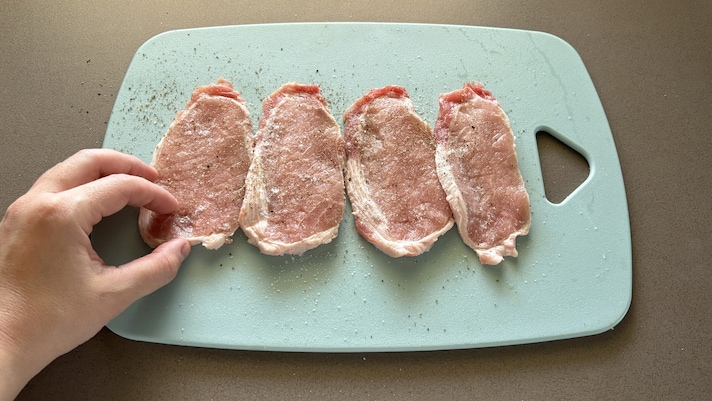
To prepare the tonkatsu, massage the pork loin slices with salt and pepper, on both sides.
To prepare the tonkatsu, massage the pork loin slices with salt and pepper, on both sides.
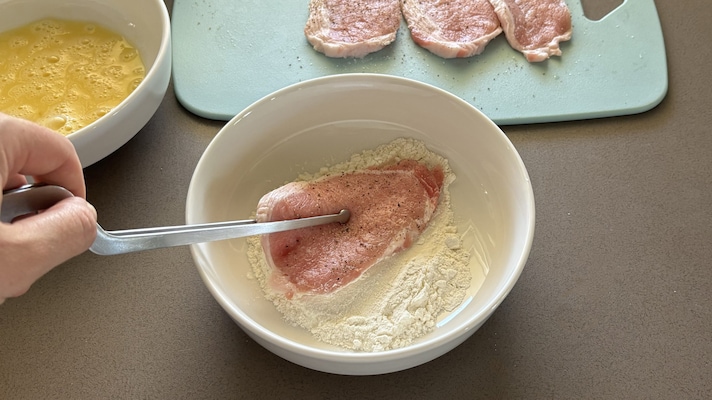
Pass the slices in the flour, covering them on both sides.
Pass the slices in the flour, covering them on both sides.
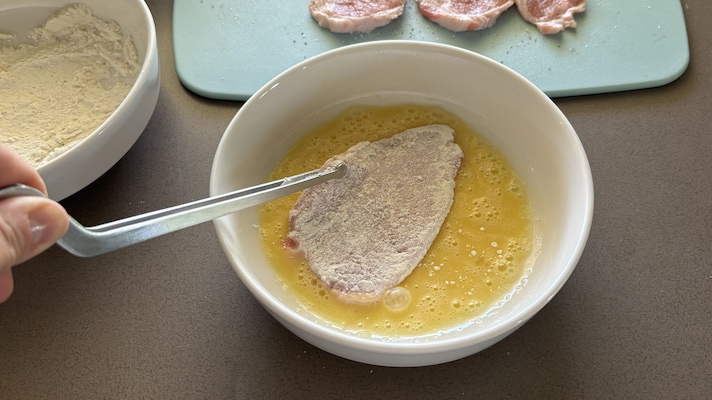
Dip them in the beaten egg.
Dip them in the beaten egg.
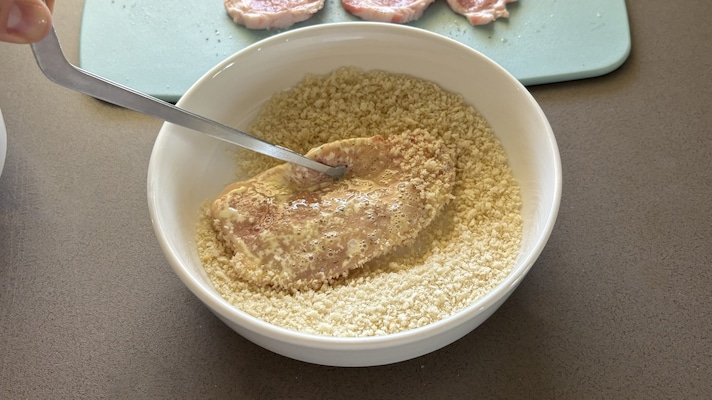
Cover them well with Japanese panko.
Cover them well with Japanese panko.
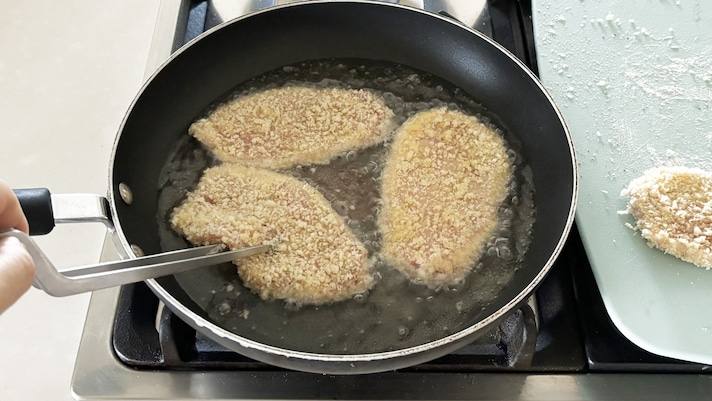
Dip the cutlets in plenty of very hot seed oil.
Dip the cutlets in plenty of very hot seed oil.
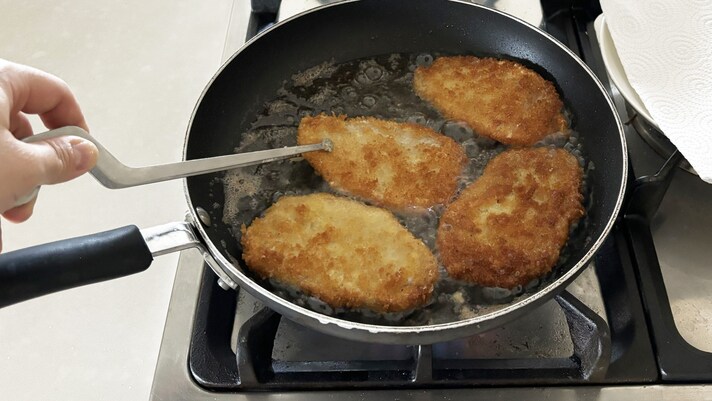
Fry them until they are golden brown on both sides.
Fry them until they are golden brown on both sides.
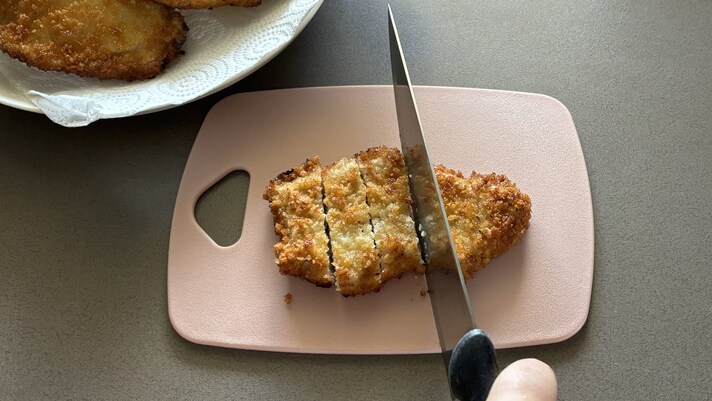
Drain the cutlets on a sheet of kitchen paper, then arrange them on a cutting board and divide them into 5-6 pieces, without breaking their shape.
Drain the cutlets on a sheet of kitchen paper, then arrange them on a cutting board and divide them into 5-6 pieces, without breaking their shape.
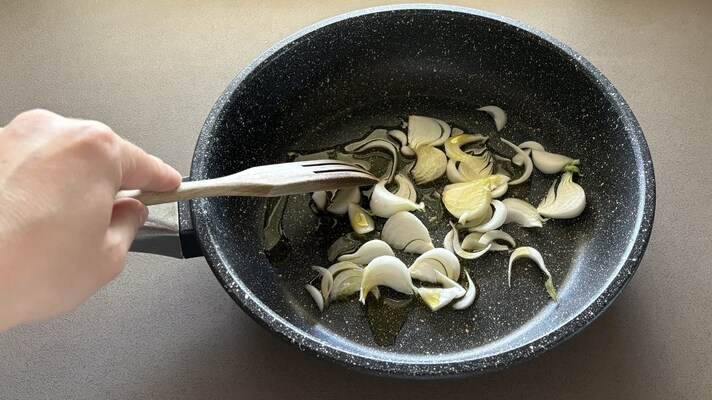
Slice the onion, then let it brown in a pan with a drizzle of seed oil.
Slice the onion, then let it brown in a pan with a drizzle of seed oil.
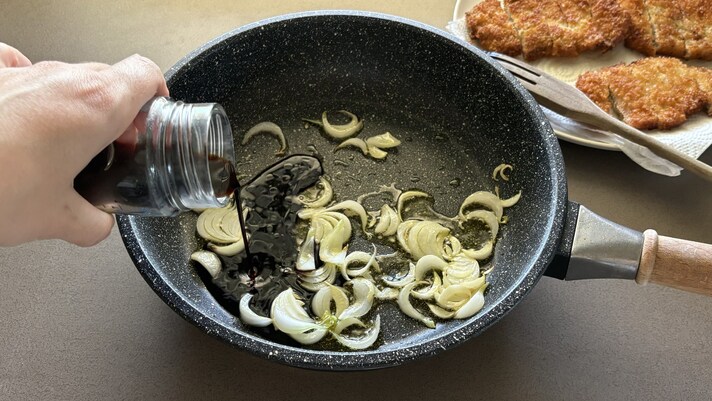
Add the soy sauce and the sugar, then mix and let them caramelize for 1-2 minutes.
Add the soy sauce and the sugar, then mix and let them caramelize for 1-2 minutes.
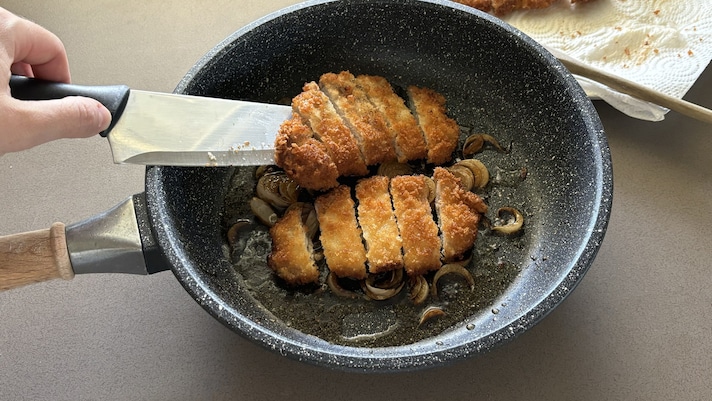
When the dressing has reduced slightly, add the cutlets, keeping them compact in their original shape.
When the dressing has reduced slightly, add the cutlets, keeping them compact in their original shape.
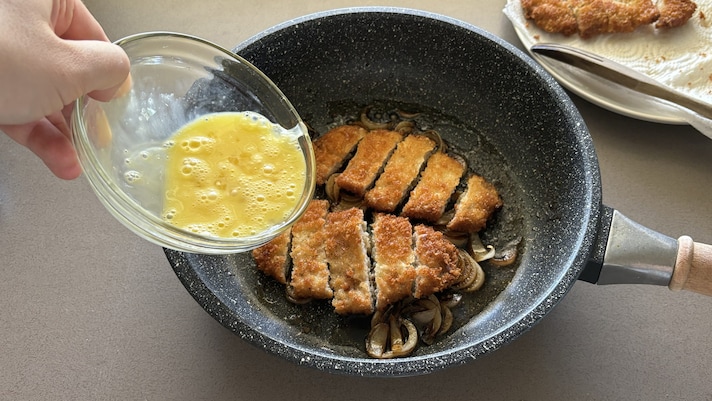
At this point, gently pour the beaten egg over the meat.
At this point, gently pour the beaten egg over the meat.

Try to cover it entirely, then cover it with a lid and cook it on low heat for 3-4 minutes.
Try to cover it entirely, then cover it with a lid and cook it on low heat for 3-4 minutes.
How to Prepare Rice
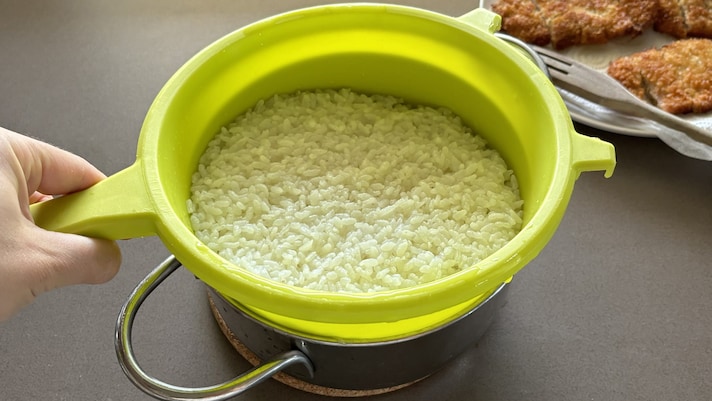
Place gohan rice or another type of sushi rice in a bowl and rinse it under running water several times until the water runs clear, to remove excess starch. Then cook it according to the instructions on the package. Once boiled, drain it well and let it cool. The grains should be slightly sticky.
Place gohan rice or another type of sushi rice in a bowl and rinse it under running water several times until the water runs clear, to remove excess starch. Then cook it according to the instructions on the package. Once boiled, drain it well and let it cool. The grains should be slightly sticky.
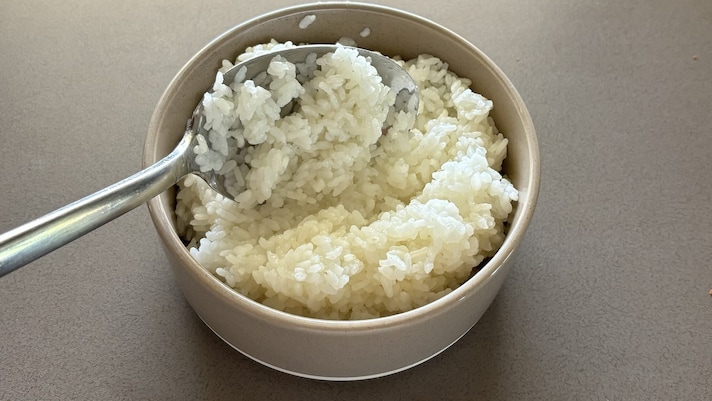
Distribute it in individual holsters.
Distribute it in individual holsters.
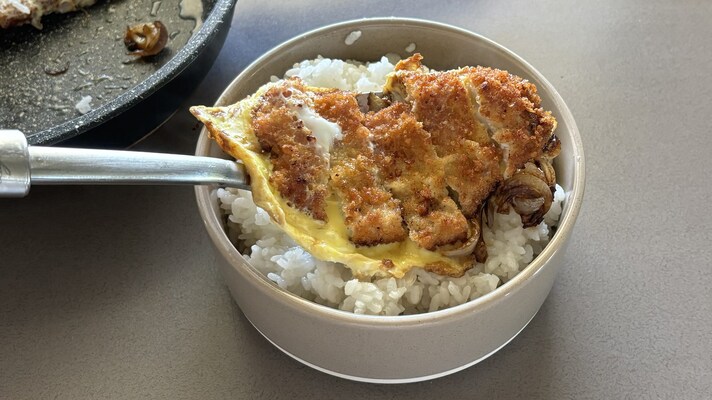
Then place the pork cutlets with the egg and onions.
Then place the pork cutlets with the egg and onions.

Garnish the katsudon with spring onion slices and serve. Enjoy!
Garnish the katsudon with spring onion slices and serve. Enjoy!
;Resize,width=767;)
